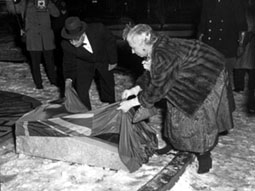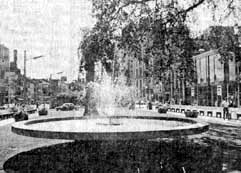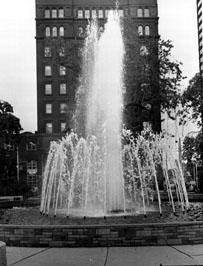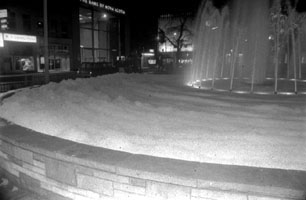Throughout the history of the City of Hamilton, the land that has come to be
known as Gore Park has been a central element of the downtown core. One of the key
features of this park is the fountain centered in the "green oasis in a desert of
asphalt". The Gore Park fountain, both past and present has come to symbolize the
spirit of an industrial community and the pride of a growing community.
The shape of Gore Park was determined in the following manner: George Hamilton, founder
of the town of Hamilton, owned land on the south side of King Street and Nathaniel Hughson
was the proprietor of land on the North side of King Street. Both agreed to present land
to the town of Hamilton to serve as a public square. George Hamilton keeping his promise,
gave a piece of land which was cut on the bias, while Hughson failed to present his part.
The land donated by Hamilton came to be known as the "Gore" and was dedicated to
the city in perpetuity as a public square.
From 1815-1850, the Gore remained an undeveloped and unsightly open space whose
predominant function served as a parking area for farmers selling wood and grain as well
as acting as a refuse heap. In 1833, a proposal was made to transform the Gore into a
market place. George Hamilton launched a lawsuit to stop the Town Council from taking this
donated land. Again in 1847 during a province wide economic slump, the Council, worried
about their finances, considered selling the Gore for development. Robert Jarvis Hamilton,
George Hamilton’s son, upon hearing of the plan for the development of the Gore,
reasserted his rights to the land. A committee was created to determine who held legal
rights to the land. In the end an agreement was reached whereby the City of Hamilton would
split the area and oversee the construction of buildings. Robert Hamilton received 2,000
pounds for waiving his rights to the city’s land. The citizens of the city were
discontented and protested and complained in response to the planned subdivision of the
Gore into building lots. In 1859, the Gore was transformed into Gore Park, satisfying the
initial intended land use.
Preparation for the First Royal visit called for the improvement and beautification of
Gore Park, which was to include the construction of a new fountain. In addition, the
fountain was of importance within a historical context as it was erected along with a
system of waterlines that were built to provide a safe supply of water to the city’s
residents. Without a supply of safe, pure, and fresh water the population was at constant
risk of epidemic. This water system would also provide the needed water for the fountain.
It was decided that a contest would be held to determine the most efficient engineering
solution to the problem of water supply in the City of Hamilton. There was a prize of ten
thousand dollars to be won. The winning design, although never implemented, proposed that
water from Lake Medad be used. Instead, the first water system for the City of Hamilton
was based on the natural filtering of water from Lake Ontario through sand into larger
pits where it was pumped into a system of pipes and into a reservoir. To celebrate this
ground breaking engineering achievement, and for the city’s first Royal visit, a
fountain was erected in the city centre, Gore Park.
The beautification of the park, including the construction and installation of the
fountain was completed in the early spring of 1860. The fountain was "a symbol of the
city representing the public spirit of citizens who wished to make their community’s
commercial core a place of beauty as well as a place of commerce." The fountain
consisted of two shallow bowl-shaped cups, the upper bowl being smaller in size than the
lower bowl, and a spire. The Victorian fountain stood approximately twenty-five feet high.
The fountain was dedicated in September 1860 by Edward Prince of Wales.
 The original fountain of Gore Park, at
the age of 99 years was condemned as unsafe, disassembled and carted away in 1959 to make
room for a new fountain donated by the Association of Kinsmen Clubs of Canada at a cost of
$10,000. The fountain, consisting of three separate saucer-shaped bowls, each measuring
eighteen feet in diameter, was dedicated to the memory of the eleven original members of
the Kinsmen Clubs in Hamilton. It was promised by both the Kinsmen and the City that the
fountain would operate year round and that coloured tiles and multi-coloured illuminations
would lend rainbow tints to the fountain spray. The Hamilton Downtown Association was
responsible for arranging the coloured lighting while a group of Hamilton industries
donated several hundred gallons of liquid that would not freeze. The Kinsmen statue was
installed on November 27, 1960.
The original fountain of Gore Park, at
the age of 99 years was condemned as unsafe, disassembled and carted away in 1959 to make
room for a new fountain donated by the Association of Kinsmen Clubs of Canada at a cost of
$10,000. The fountain, consisting of three separate saucer-shaped bowls, each measuring
eighteen feet in diameter, was dedicated to the memory of the eleven original members of
the Kinsmen Clubs in Hamilton. It was promised by both the Kinsmen and the City that the
fountain would operate year round and that coloured tiles and multi-coloured illuminations
would lend rainbow tints to the fountain spray. The Hamilton Downtown Association was
responsible for arranging the coloured lighting while a group of Hamilton industries
donated several hundred gallons of liquid that would not freeze. The Kinsmen statue was
installed on November 27, 1960.
In the summer prior to the installation of the Kinsmen fountains, a cheque for the
amount of two hundred dollars arrived at the offices of the Spectator in trust strictly
for the rehabilitation of the former Gore fountain. Whether an omen or mere coincidence,
the timely arrival of this cheque seemed to foreshadow the fate of the Kinsmen fountain.
 Within two months of being erected,
the fountain came under criticism. According to public criticism as printed in the
Spectator (June 13, 1963), the saucer-fountains had been referred to as "flying
saucers", "gravy bowls", and "pie-dishes". Contrary to the
promise made by the Kinsmen, the fountains did not work efficiently and at most times were
dry. One gentleman alluded to the fact that his garden hose could do a better job than the
fountain.
Within two months of being erected,
the fountain came under criticism. According to public criticism as printed in the
Spectator (June 13, 1963), the saucer-fountains had been referred to as "flying
saucers", "gravy bowls", and "pie-dishes". Contrary to the
promise made by the Kinsmen, the fountains did not work efficiently and at most times were
dry. One gentleman alluded to the fact that his garden hose could do a better job than the
fountain.
What became of the old Victorian fountain of Gore Park? The main bowl of the fountain
and the base had been demolished as they could not be saved. A small item which appeared
in the 1959 report of the Board of Park Management stated that "the top section of
the fountain was found to be in good condition and is now in storage awaiting a suitable
location where it will be re-erected." It was further suggested that "perhaps a
bottom part could be fashioned for it so that it could be restored in some way reminiscent
of the old landmark erected in the Gore just 100 years ago." (Spectator, May 12,
1960).
This is exactly what happened. When Josephine Hyslop (a private citizen) died, she left
three thousand dollars to the Parks Board to erect a fountain in memory of her late son
Edward. In 1964, the Park’s Board built a large stone basin and concrete pillar
mounting the ornate dish that once topped the old Gore fountain on the new fountain. This
new fountain was located at the Delta.
 In the late 1960s it was decided that
Gore Park, once again, needed a complete facelift. Again, the central focus of the
refurbished park was a new fountain to replace the failed Kinsmen fountain. The new
fountain consisted of an oval bowl with a twenty-five foot spray in the middle surrounded
by many smaller jets. There were forty-four lights that went through fourteen colour
combinations. The total cost of the facelift, including the price of the new fountain was
tagged at $135,000. This new fountain came to be described as "a miniature Niagara
Falls for Downtown Hamilton". This fountain was erected in 1970.
In the late 1960s it was decided that
Gore Park, once again, needed a complete facelift. Again, the central focus of the
refurbished park was a new fountain to replace the failed Kinsmen fountain. The new
fountain consisted of an oval bowl with a twenty-five foot spray in the middle surrounded
by many smaller jets. There were forty-four lights that went through fourteen colour
combinations. The total cost of the facelift, including the price of the new fountain was
tagged at $135,000. This new fountain came to be described as "a miniature Niagara
Falls for Downtown Hamilton". This fountain was erected in 1970.
In 1971, the Gore Park fountain faced sea of suds. During the night, a group of
individuals had placed washing powder into the fountain which resulted in the creation of
immense amounts of suds in the fountain water. The fountain was not damaged. The
"washing-powder-in-the-fountain trick" was not a new prank.
In the early 1990s the Head-Of-The-Lake
Historical Society called for the recreation and reinstallation of the original Gore
Park Fountain to mark the City of Hamilton’s Sesquicentennial (150th) anniversary
which was to occur in 1996. A group of people belonging to the Head-Of-The-Lake Historical
Society formed the Fountain Foundation through the Society. The foundation, led by Dennis
Misset and a group of volunteers pushed to raise hundreds of thousands of dollars to build
a copy of the Victorian original. The estimated cost of this desired project was $525,000.
According to Mr. Ray Harris, fundraising chairman: "We are going to raise it totally
from private funds. We have the full backing of the City Council. This is going to be the
jewel in the crown of downtown regeneration."
 Expert
accounting was volunteered by Mark Walters of Price Waterhouse and a landscape architect,
William Fraser volunteered to design the renewed Victorian theme of the Park to complement
the fountain. Special help was also provided by Jack MacDonald and Ray Harris. Archie
McCoy, the owner of the Flamborough Foundry responsible for constructing the massive cast
iron monument estimated that the replica fountain weighed over twenty-five tons and was
over twenty-five feet high. The upper bowl and spire saved from the original fountain were
added. In addition, there were twelve lights, one fifteen-horse power engine, and
twenty-four jets of water functioning at three different auto-adjusting settings: low,
medium and high.
Expert
accounting was volunteered by Mark Walters of Price Waterhouse and a landscape architect,
William Fraser volunteered to design the renewed Victorian theme of the Park to complement
the fountain. Special help was also provided by Jack MacDonald and Ray Harris. Archie
McCoy, the owner of the Flamborough Foundry responsible for constructing the massive cast
iron monument estimated that the replica fountain weighed over twenty-five tons and was
over twenty-five feet high. The upper bowl and spire saved from the original fountain were
added. In addition, there were twelve lights, one fifteen-horse power engine, and
twenty-four jets of water functioning at three different auto-adjusting settings: low,
medium and high.
 The City of Hamilton was now faced
with a quandry: where would the home for the new fountain be located? In the days of the
original fountain, the park extended from James Street to Hughson Street. In 1860, the
then new fountain was placed in the centre of the park. Today the park extends from
Hughson Street east of John Street making Hughson street the centre of the park. It was
now that the City met with the location debate. Many proposals were put forth. Some
preferred the fountain to be placed in the original site while others proposed a location
in the middle of Hughson Street which would be closed to traffic, extending the park to
John Street. This new location would have cost the city $200,000 more than placing the
fountain in the original site. On March 29,1995, the City Council voted 7-2 in favor of
placing the replica between James and Hughson, returning it to its original home.
The City of Hamilton was now faced
with a quandry: where would the home for the new fountain be located? In the days of the
original fountain, the park extended from James Street to Hughson Street. In 1860, the
then new fountain was placed in the centre of the park. Today the park extends from
Hughson Street east of John Street making Hughson street the centre of the park. It was
now that the City met with the location debate. Many proposals were put forth. Some
preferred the fountain to be placed in the original site while others proposed a location
in the middle of Hughson Street which would be closed to traffic, extending the park to
John Street. This new location would have cost the city $200,000 more than placing the
fountain in the original site. On March 29,1995, the City Council voted 7-2 in favor of
placing the replica between James and Hughson, returning it to its original home.
In keeping with the tradition of old, two school children were chosen from hundreds
(who participated in a fountain colouring contest) to push a button beginning the water
works at the replica fountain unveiling. The fountain was unveiled at the sesquicentennial
ceremonies celebrating the anniversary of the City of Hamilton in 1996. The replica
fountain now resides in Gore Park.
 The original fountain of Gore Park, at
the age of 99 years was condemned as unsafe, disassembled and carted away in 1959 to make
room for a new fountain donated by the Association of Kinsmen Clubs of Canada at a cost of
$10,000. The fountain, consisting of three separate saucer-shaped bowls, each measuring
eighteen feet in diameter, was dedicated to the memory of the eleven original members of
the Kinsmen Clubs in Hamilton. It was promised by both the Kinsmen and the City that the
fountain would operate year round and that coloured tiles and multi-coloured illuminations
would lend rainbow tints to the fountain spray. The Hamilton Downtown Association was
responsible for arranging the coloured lighting while a group of Hamilton industries
donated several hundred gallons of liquid that would not freeze. The Kinsmen statue was
installed on November 27, 1960.
The original fountain of Gore Park, at
the age of 99 years was condemned as unsafe, disassembled and carted away in 1959 to make
room for a new fountain donated by the Association of Kinsmen Clubs of Canada at a cost of
$10,000. The fountain, consisting of three separate saucer-shaped bowls, each measuring
eighteen feet in diameter, was dedicated to the memory of the eleven original members of
the Kinsmen Clubs in Hamilton. It was promised by both the Kinsmen and the City that the
fountain would operate year round and that coloured tiles and multi-coloured illuminations
would lend rainbow tints to the fountain spray. The Hamilton Downtown Association was
responsible for arranging the coloured lighting while a group of Hamilton industries
donated several hundred gallons of liquid that would not freeze. The Kinsmen statue was
installed on November 27, 1960. Throughout the history of the City of Hamilton, the land that has come to be
known as Gore Park has been a central element of the downtown core. One of the key
features of this park is the fountain centered in the "green oasis in a desert of
asphalt". The Gore Park fountain, both past and present has come to symbolize the
spirit of an industrial community and the pride of a growing community.
Throughout the history of the City of Hamilton, the land that has come to be
known as Gore Park has been a central element of the downtown core. One of the key
features of this park is the fountain centered in the "green oasis in a desert of
asphalt". The Gore Park fountain, both past and present has come to symbolize the
spirit of an industrial community and the pride of a growing community.
 Within two months of being erected,
the fountain came under criticism. According to public criticism as printed in the
Spectator (June 13, 1963), the saucer-fountains had been referred to as "flying
saucers", "gravy bowls", and "pie-dishes". Contrary to the
promise made by the Kinsmen, the fountains did not work efficiently and at most times were
dry. One gentleman alluded to the fact that his garden hose could do a better job than the
fountain.
Within two months of being erected,
the fountain came under criticism. According to public criticism as printed in the
Spectator (June 13, 1963), the saucer-fountains had been referred to as "flying
saucers", "gravy bowls", and "pie-dishes". Contrary to the
promise made by the Kinsmen, the fountains did not work efficiently and at most times were
dry. One gentleman alluded to the fact that his garden hose could do a better job than the
fountain.  In the late 1960s it was decided that
Gore Park, once again, needed a complete facelift. Again, the central focus of the
refurbished park was a new fountain to replace the failed Kinsmen fountain. The new
fountain consisted of an oval bowl with a twenty-five foot spray in the middle surrounded
by many smaller jets. There were forty-four lights that went through fourteen colour
combinations. The total cost of the facelift, including the price of the new fountain was
tagged at $135,000. This new fountain came to be described as "a miniature Niagara
Falls for Downtown Hamilton". This fountain was erected in 1970.
In the late 1960s it was decided that
Gore Park, once again, needed a complete facelift. Again, the central focus of the
refurbished park was a new fountain to replace the failed Kinsmen fountain. The new
fountain consisted of an oval bowl with a twenty-five foot spray in the middle surrounded
by many smaller jets. There were forty-four lights that went through fourteen colour
combinations. The total cost of the facelift, including the price of the new fountain was
tagged at $135,000. This new fountain came to be described as "a miniature Niagara
Falls for Downtown Hamilton". This fountain was erected in 1970. Expert
accounting was volunteered by Mark Walters of Price Waterhouse and a landscape architect,
William Fraser volunteered to design the renewed Victorian theme of the Park to complement
the fountain. Special help was also provided by Jack MacDonald and Ray Harris. Archie
McCoy, the owner of the Flamborough Foundry responsible for constructing the massive cast
iron monument estimated that the replica fountain weighed over twenty-five tons and was
over twenty-five feet high. The upper bowl and spire saved from the original fountain were
added. In addition, there were twelve lights, one fifteen-horse power engine, and
twenty-four jets of water functioning at three different auto-adjusting settings: low,
medium and high.
Expert
accounting was volunteered by Mark Walters of Price Waterhouse and a landscape architect,
William Fraser volunteered to design the renewed Victorian theme of the Park to complement
the fountain. Special help was also provided by Jack MacDonald and Ray Harris. Archie
McCoy, the owner of the Flamborough Foundry responsible for constructing the massive cast
iron monument estimated that the replica fountain weighed over twenty-five tons and was
over twenty-five feet high. The upper bowl and spire saved from the original fountain were
added. In addition, there were twelve lights, one fifteen-horse power engine, and
twenty-four jets of water functioning at three different auto-adjusting settings: low,
medium and high. The City of Hamilton was now faced
with a quandry: where would the home for the new fountain be located? In the days of the
original fountain, the park extended from James Street to Hughson Street. In 1860, the
then new fountain was placed in the centre of the park. Today the park extends from
Hughson Street east of John Street making Hughson street the centre of the park. It was
now that the City met with the location debate. Many proposals were put forth. Some
preferred the fountain to be placed in the original site while others proposed a location
in the middle of Hughson Street which would be closed to traffic, extending the park to
John Street. This new location would have cost the city $200,000 more than placing the
fountain in the original site. On March 29,1995, the City Council voted 7-2 in favor of
placing the replica between James and Hughson, returning it to its original home.
The City of Hamilton was now faced
with a quandry: where would the home for the new fountain be located? In the days of the
original fountain, the park extended from James Street to Hughson Street. In 1860, the
then new fountain was placed in the centre of the park. Today the park extends from
Hughson Street east of John Street making Hughson street the centre of the park. It was
now that the City met with the location debate. Many proposals were put forth. Some
preferred the fountain to be placed in the original site while others proposed a location
in the middle of Hughson Street which would be closed to traffic, extending the park to
John Street. This new location would have cost the city $200,000 more than placing the
fountain in the original site. On March 29,1995, the City Council voted 7-2 in favor of
placing the replica between James and Hughson, returning it to its original home.